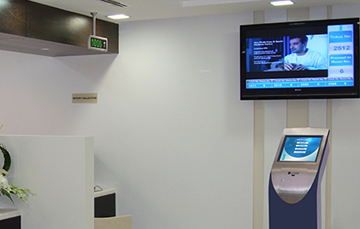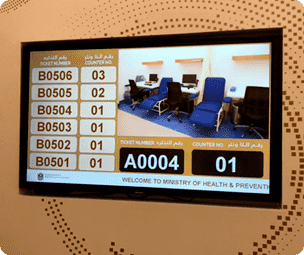In today’s rapidly evolving world, digital signage is revolutionizing various industries, and the healthcare sector is no exception. Digital signage refers to dynamic displays that utilize technology to deliver visual content, information, and messages.
When it comes to health facilities, the potential to improve healthcare with digital signage and enhance communication is immense.
The health sector is a complex ecosystem comprising hospitals, clinics, and healthcare facilities, all dedicated to providing quality patient care. However, navigating these environments and effectively communicating crucial information can be challenging.
This is where digital signage steps in to make a significant impact. By strategically placing interactive displays and vibrant screens, healthcare facilities can streamline communication, provide timely updates, and deliver essential information to patients, visitors, and staff.
In this article, we delve into the ways in which digital signage can improve healthcare. From enhancing communication and reducing confusion to offering wayfinding assistance and empowering patient education, digital signage holds the key to transforming healthcare experiences.
Join us as we explore the immense potential of digital signage in improving healthcare delivery and fostering positive patient outcomes.
Importance of Digital Signage in the Health Sector
In the rapidly evolving healthcare landscape, digital signage has emerged as a powerful tool to transform healthcare facilities’ operations and improve patient experiences.
Implementing digital signage systems in healthcare offers numerous advantages that contribute to enhanced communication, improved patient experience, and increased efficiency throughout the sector.
1. Advantages of Implementing Digital Signage Systems in Healthcare
Digital signage systems provide a dynamic platform to effectively communicate important information to patients, visitors, and staff. Real-time updates, appointment reminders, and general announcements can be displayed, reducing confusion and keeping everyone informed.
This enhances communication and creates a more organized and efficient healthcare environment.
2. Improving Patient Experience with Digital Signage Systems
Digital signage systems play a vital role in enhancing the overall patient experience. Interactive displays can provide wayfinding assistance, guide patients and visitors through complex healthcare facilities, minimize stress, and save valuable time.
Additionally, these systems can deliver personalized educational content, empowering patients to make informed decisions about their health and treatment options.
3. Increasing Efficiency in Healthcare through Digital Signage
Digital signage systems contribute to increased efficiency in healthcare settings. They can display real-time wait times, enabling patients to plan their activities accordingly.
Furthermore, digital signage assists with staff allocation and resource management, ensuring streamlined operations and reduced bottlenecks.
In conclusion, implementing digital signage systems in healthcare offers many advantages, ranging from improved communication and enhanced patient experiences to increased operational efficiency.
By leveraging the power of digital signage, healthcare facilities can create a more patient-centric environment and ultimately elevate patient care quality.
The Benefits of Digital Signage Systems for Hospitals
Let’s explore the remarkable benefits that digital signage systems bring to hospitals, elevating the standard of care and revolutionizing the healthcare experience for patients, staff, and visitors alike.
- Improving Patient Experience and Engagement
- Queue management and wait-time information
- Remote monitoring and maintenance
- Integration with scheduling systems
- Enhanced Communication and Patient Satisfaction
- Increased Compliance and Awareness
- Visitor Data Collection
- Real-time updates and alerts
1. Improving Patient Experience and Engagement
Digital signage can revolutionize patient experience and engagement, significantly improving healthcare. By implementing digital signage solutions, hospitals can provide timely and relevant information to patients, reducing anxiety and enhancing their overall experience.
Interactive displays can empower patients with self-service options, enabling them to access educational resources and personalized content.
Additionally, digital signage facilitates patient engagement by displaying important updates, appointment reminders, and wayfinding information. This creates a more informed and engaged patient population and contributes to better outcomes and satisfaction.
Improving healthcare with digital signage is a transformative approach that improves the process, elevating patient experience and fostering active participation in their care.

2. Queue Management and Wait-Time Information
Increasing Efficiency in Healthcare through Digital Signage extends to queue management systems for patients and wait-time information. Digital signage systems enable hospitals to efficiently manage patient queues by displaying real-time wait times and updates.
This information allows patients to make informed decisions and reduces anxiety associated with uncertain wait times. By providing transparent and accurate wait-time information, digital signage enhances patient satisfaction, streamlines patient flow, and optimizes resource allocation.
This improved queue management solution contributes to overall operational efficiency, ensuring a smoother and more organized healthcare experience for both patients and staff.
3. Remote Monitoring and Maintenance
Improving Patient Experience with Digital Signage Systems also extends to remote monitoring and maintenance capabilities. Digital signage systems can be remotely monitored and managed for efficient content updates, troubleshooting, and maintenance.
This remote access reduces the need for on-site interventions, saving time and resources. Additionally, remote monitoring enables real-time content customization and ensures that the information displayed remains up-to-date and relevant.
By leveraging remote monitoring and maintenance, hospitals can ensure the seamless operation of their digital signage systems, leading to a consistent and enhanced patient experience and better customer feedback.
4. Integration with Scheduling Systems
One of the advantages of implementing digital signage systems in healthcare is the integration with scheduling systems. Integrating with cloud-based appointment platforms allows digital signage to display real-time appointment schedules, updates, and reminders.
This integration streamlines the patient journey, reducing check-in times and improving overall efficiency. Patients can easily view their appointment status, verify waiting times, and access relevant information through digital signage.
This integration enhances communication, reduces patient anxiety, and ensures a seamless experience from appointment scheduling to in-person visits, ultimately improving patient satisfaction and optimizing healthcare operations.
5. Enhanced Communication and Patient Satisfaction
Improving healthcare through digital signage systems results in enhanced communication and patient satisfaction. For example, alongside dynamic displays, ticket dispensers integrated with digital signage provide a seamless patient journey.
Patients can obtain their tickets from the dispenser, which displays clear instructions and information through digital signage. This reduces confusion and empowers patients to navigate the process with ease.
By displaying real-time updates, wait times, and informative content, digital signage systems keep patients engaged and informed, enhancing their overall experience.
This efficient communication streamlines operations, reduces perceived wait times, and increases patient satisfaction, ultimately improving the healthcare environment.

6. Increased Compliance and Awareness
The advantages of implementing digital signage systems in healthcare extend to increased compliance and awareness. By displaying important guidelines, safety protocols, and educational content, digital signage promotes compliance with regulations and enhances patient awareness.
Additionally, digital signage systems capture valuable data through business analytics, providing insights into content effectiveness and patient engagement.
Hospitals can leverage this information to tailor messaging, improve communication strategies, and drive informed decision-making.
Through increased compliance and awareness, digital signage systems contribute to a safer and more informed healthcare environment, ultimately improving patient outcomes and satisfaction.
7. Visitor Data Collection
Digital signage systems in healthcare can facilitate visitor data collection through the implementation of people-counting technology. By utilizing sensors and analytics, digital signage can accurately count and track the number of visitors in specific areas.
This data provides valuable insights into visitor traffic patterns, peak hours, and overall facility utilization. Hospitals can leverage this information to optimize resource allocation, streamline operations, and enhance visitor experiences.
Visitor data collection through people-counting technology empowers healthcare facilities to make data-driven decisions, improve crowd management, and provide visitors with a more efficient and personalized environment.
8. Real-Time Updates and Alerts
Increasing Efficiency in Healthcare through Digital Signage includes delivering real-time updates and alerts. In real-time, digital signage systems enable healthcare facilities to display critical information such as emergency notifications, safety protocols, and important announcements.
This ensures that patients, staff, and visitors are promptly informed about any changes or urgent updates. By providing instant alerts and updates, digital signage enhances communication, improves situational awareness, and contributes to a more efficient healthcare environment.
Whether it’s notifying patients of delays or sharing vital information during emergencies, real-time updates and alerts through digital signage systems play a crucial role in maintaining a well-informed and responsive healthcare facility.

Improve Healthcare with Digital Signage – FAQs
How Does Digital Signage Benefit Patient Communication?
Digital signage benefits patient communication by providing a dynamic real-time platform to display important information, updates, and educational content, enhancing patient engagement and understanding.
Can Digital Signage Be Customized for Different Healthcare Facilities?
Yes, digital signage can be customized for different healthcare facilities, allowing for tailored content, branding, and specific information to meet the unique needs of each facility and its patients.
Is Digital Signage Cost-Effective in The Long Run?
Digital signage is cost-effective in the long run as it eliminates the need for printing and distributing physical materials, allows for easy content updates, reduces wait times, and enhances operational efficiency, leading to improved patient satisfaction and potentially reducing overall costs.
Closing Remarks
Digital transformation in healthcare is revolutionizing the industry, and one aspect of this transformation is the implementation of digital signage. This technology has the potential to improve patient experiences and outcomes significantly.
Digital signage systems offer numerous advantages by enhancing communication, streamlining operations, and fostering positive patient outcomes.
With dynamic displays, hospitals can effectively communicate important information, reducing confusion and anxiety while promoting compliance and awareness.
Real-time updates, educational content, and personalized messaging empower patients, leading to increased engagement, understanding, and better healthcare outcomes.
The flexibility of digital signage allows customization to meet the unique needs of healthcare facilities, ensuring that the content aligns with specific requirements and branding.
From a cost perspective, digital signage proves to be a cost-effective solution by reducing reliance on printed materials, enabling easy content updates, and optimizing operational efficiency.
Embracing this transformative tool creates a more patient-centered environment, enhances communication, and delivers exceptional care.
As technology advances, the integration of digital signage will continue to shape and improve healthcare experiences for patients, staff, and visitors alike, further enhancing the future of healthcare.
BOOK A FREE DEMO




